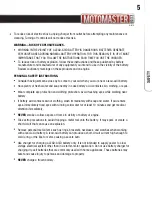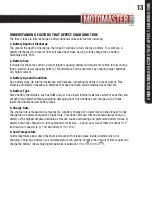
tabs
co
ntinu
ation tabs
headline bars
tabs
continuation tabs
notes
warnings
Model no. 011-1975-8 l Questions? Contact us 1-888-942-6686
8
CONNECTING YOUR BATTERY
CONNECTING YOUR BATTERY
FOLLOW THESE STEPS WHEN BATTERY IS INSTALLED IN VEHICLE
WARNING: A SPARK NEAR THE BATTERY MAY CAUSE A BATTERY EXPLOSION. TO REDUCE THE
RISK OF A SPARK NEAR THE BATTERY:
Position AC and DC cords to reduce risk of damage by hood, door or moving engine part.
Stay clear of fan blades, belts, pulleys, and other parts that can cause injury to persons.
Check polarity of battery posts. POSITIVE (POS, P, +) battery post usually has a larger diameter
than NEGATIVE (NEG, N, -) post.
Determine which post of battery is grounded (connected) to the chassis.
If negative post is grounded to chassis (as in most vehicles), see step "For negative-grounded
vehicle". If positive post is grounded to the chassis, see step "For positive-grounded vehicle".
For negative-grounded vehicle, connect POSITIVE (RED) clip from battery charger to POSITIVE
(POS, P, +) ungrounded post of battery. Connect NEGATIVE (BLACK) clip to vehicle chassis or
engine block away from battery. Do not connect clip to carburetor, fuel lines, or sheet-metal body
parts. Connect to a heavy-gauge metal part of the frame or engine block.
For positive-grounded vehicle, connect NEGATIVE (BLACK) clip from battery charger to NEGATIVE
(NEG, N, -) ungrounded post of battery. Connect POSITIVE (RED) clip to vehicle chassis or engine
block away from battery. Do not connect clip to carburetor, fuel lines, or sheet-metal body parts.
Connect to a heavy-gauge metal part of the frame or engine block.
When disconnecting charger, turn switches to off, disconnect AC cord, remove clip from vehicle
chassis, and then remove clip from battery terminal.


































